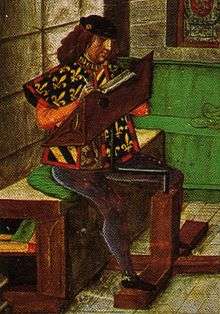Jean Le Fèvre de Saint-Remy
Jean le Fèvre de Saint-Remy or Jean Lefebvre de Saint-Remy (c. 1394 – June 16, 1468) born in Abbeville,[1] was a Burgundian chronicler during the Hundred Years' War and lord (seigneur) of Saint Remy, la Vacquerie, Avesnes and Morienne.[1] He is also known by the formal title of authority Toison d'or (Golden Fleece) because he served as the King of Arms to the Order of the Golden Fleece.[1][2]
Jean Le Fèvre de Saint-Remy | |
|---|---|
 Depiction of Jean le Fèvre de Saint-Remy as Toison d'Or King of Arms, dated c. 1450 | |
| Born | c.1394 |
| Died | June 16, 1468 |
| Occupation | chronicler |
- To be distinguished from Jean Le Fèvre, bishop of Chartres 1380-1389, Jean Le Fèvre (canon) and Jean Le Fevre (astronomer) 1420-1435
Biography
Of noble birth, he adopted the profession of arms and with other Burgundians fought in the English ranks at the Battle of Agincourt. Following the foundation of the Order of the Golden Fleece in 1430 by Philip the Good, Duke of Burgundy, at the Order's chapter meeting in Lille (November 1431) Le Fèvre was appointed its king of arms and he soon became a very influential person at the Burgundian court.[3] As counsellor to the duke of Burgundy, he frequently assisted Philip III in conducting negotiations with foreign powers, and he was an arbiter in tournaments and authority on all questions of chivalry, where his wide expert knowledge of heraldry was highly respected.[3] Recognition of distinction for his services in the form adoubement and knighthood ensued late in Le Fèvre's life: the medieval chronicler Georges Chastellain describes a moving scene at the occasion of the Order's chapter meeting in Bruges in May 1468, where the King of Arms Le Fèvre retired from service on the grounds of old age.[3] Shortly after the Order's tribute in his honour, Le Fèvre died at Bruges of natural causes on 16 June 1468.[3]
Le Fèvre also wrote a chronicle or history of Charles VI of France. The greater part of this chronicle is a resumption of the work of Enguerrand de Monstrelet, but Le Fèvre is an original authority for the years between 1428 and 1436 and makes some valuable additions to our knowledge, especially about the chivalry of the Burgundian court. He is more concise than Monstrelet, but is equally partial to the dukes of Burgundy. The chronicle has been edited by F. Morand for the Société de l'histoire de France (Paris, 1876): Chronique de Jean le Fèvre Seigneur de Saint Rémy. Le Fèvre is usually regarded as the author of Livre des Faits de Jacques Lalaing, a chronicle biography on the events of the Burgundian knight Jacques de Lalaing.
References
- Buchon, Jean Alexandre (1838). Choix de chroniques et mémoires sur l'histoire de France: avec notices [Selection of chronicles and memoirs on the history of France: with notices] (in French). 2. Paris: Auguste Desrez. pp. xj-xvj (11-16).
- Françoise de Gruben Les chapitres de la Toison d'or à l'époque bourguignonne (1430-1477) 1997 Page 36 "Jean Le Fevre de Saint-Remy Le premier roi d'armes de la Toison d'Or fut le fameux Jean Le Fevre de Saint-Remy, connu grâce à sa ..."
- Oschema, Klaus (2006). Freundschaft und Nähe im spätmittelalterlichen Burgund: Studien zum Spannungsfeld von Emotion und Institution [Friendship and closeness in late medieval Burgundy: studies of the tension between Emotion and Institution] (in German). Köln: Böhlau Verlag, Köln Weimar Wein. pp. 209–210. ISBN 9783412365059.

Further reading
- Buchon, Jean Alexandre (1838). Choix de chroniques et mémoires sur l'histoire de France: avec notices [Selection of chronicles and memoirs on the history of France: with notices] (in French). 2. Paris: Auguste Desrez. pp. xj-xvj (11-16).